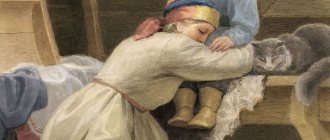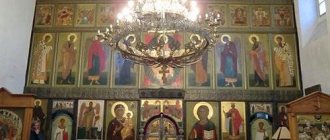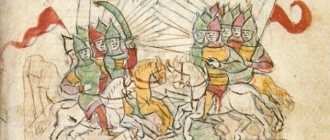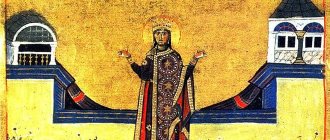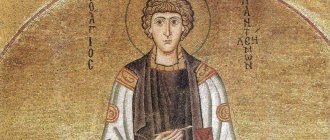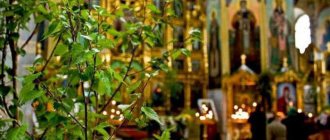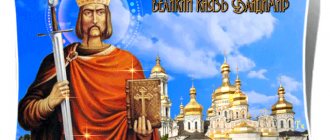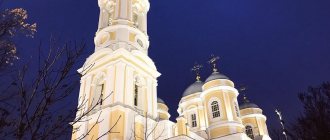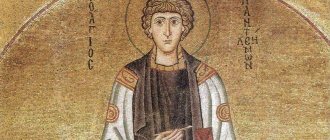"Save me, God!".
Thank you for visiting our website, before you start studying the information, please subscribe to our Orthodox community on Instagram, Lord, Save and Preserve † - https://www.instagram.com/spasi.gospodi/. The community has more than 60,000 subscribers. There are many of us like-minded people and we are growing quickly, we post prayers, sayings of saints, prayer requests, and timely post useful information about holidays and Orthodox events... Subscribe. Guardian Angel to you!
In many Orthodox churches there is an icon of Prince Vladimir, thanks to whom Rus' was baptized. He was a wise, far-sighted ruler, and his choice of a new religion had a decisive influence on the further history of Rus'.
Prince Vladimir: life story and role in history
Prince Vladimir's father was the Kiev prince Svyatoslav Igorevich, his mother was the housekeeper Malusha, and his grandmother was Princess Olga, who was the first of the Russian rulers to be baptized. It was under the leadership of the grandmother that the future prince was raised.
Vladimir faced a long and difficult path to the reign of Kyiv. The prince ruled in Kyiv for 37 years and had absolutely no intention of abandoning paganism; he led a dissolute and riotous lifestyle. He had many wives and a huge harem of concubines, but still Vladimir converted to Christianity, and after that he baptized all of Rus'.
The best article for you, go to: Saint Niphon of Cyprus: icon, life
The choice of Christianity as a new religion for Rus' is a wise political move, but the instructions received in childhood from the baptized Princess Olga also played a key role. After baptism, noticeable changes occurred in the prince; chronicles tell about this.
He became meek and merciful, generous to the orphaned and wretched. There were also changes in Vladimir's family life; he got married and lived with only one wife, the Byzantine princess Anna. After baptism in Rus', the spread of literacy and the construction of Orthodox churches began.
The Russian prince went down in history as Vladimir the Red Sun, and was later canonized as a holy prince equal to the apostles, that is, equated with the apostles for the spread of Christianity.
Saint Equal to the Apostles
Vladimir decided to be baptized, but did not want to subjugate Rus' to the Greeks. Therefore, soon after the return of the ambassadors, Vladimir went to war against the Greeks and took Chersonesus. From here he sent ambassadors to Constantinople to the emperors Vasily and Constantine demanding the hand of their sister, Princess Anna. They answered him that the princess could only be the wife of a Christian. Then Vladimir announced that he wanted to accept the Christian faith. But before the bride arrived in Chersonesos, Vladimir was struck by blindness.
In this state, like the Apostle Paul, he recognized his spiritual weakness and prepared for the great mystery of rebirth. The princess, who arrived in Chersonesus, advised him to hasten with Baptism. Vladimir was baptized (988) and was named Vasily.
The main transformation and enlightenment was the soul of the prince himself, who realized the lack of spirituality and cruelty of paganism. In 988, Prince Vladimir converted to Christianity in Korsun (Chersonese, which was then a Byzantine colony), married the Orthodox princess Anna and began the process of Christianization and missionary work in the state. In the Dnieper and Pochayna rivers he baptized the squad, boyars and courtiers. Now above the place of their Baptism on the Kyiv Mountains there is a monument to Prince Vladimir.
Your name day will be the day of remembrance of the saint in whose honor you are named in Baptism, your patron saint, your namesake, to whom you can pray as your intercessor. In addition, you can choose your own patron saint if you have not yet been baptized or do not know who you are named after. Therefore, any person named Vladimir can pray to Prince Vladimir, considering him his heavenly patron. But you can also calculate the name according to the calendar - for example, in the Church there are holy new martyrs-priests and bishops named Vladimir, who suffered for Christ already in the twentieth century. History knows a lot of famous Vladimirs: Monomakh and Putin, Lenin and Nabokov, Mayakovsky and Vysotsky... The names are the same, the people are different.
You are like a merchant looking for good beads, / glorious Vladimir, / at the height of the table sits the mother of the city, God-saved Kiev: / testing and sending to the Royal City / lead away the Orthodox faith, / you have found priceless pearls - Christ, / who chose you as the second Paul ,/ and shook off blindness in the holy font,/ both spiritual and physical./ Moreover, we celebrate your dormition,/ your people // pray to be saved by your Russian ruler and many ownership.
Description of the icon
The first painted images of “St. Vladimir” appeared in the 15th century; sometimes there are icons with the lives of the ruler. As a rule, the image of “Holy Prince Vladimir” is full-length or half-length, depicting him in princely vestments and a crown, with a cross in his right hand. On some faces, his sword is in his left hand as a symbol of reliable defense of the state; on others there is a scroll with a prayer.
You can also find a double icon, where Vladimir is depicted with his grandmother, the holy Equal-to-the-Apostles Princess Olga, who was the first to convert to Christianity.
The best article for you, go to: St. Theophan the Recluse
Where is the icon
There are many holy places in Russia where the icon of Saint Prince Vladimir is kept. Several temples have been built in honor of the saint, where you can always venerate his image:
- Church of the Holy Equal-to-the-Apostles Prince Vladimir at the Moscow Cossack Corps;
- Church of the Holy Equal-to-the-Apostles Prince Vladimir in Saratov;
- Church of St. Prince Vladimir in Voronezh.
The Orthodox people sincerely pray to the Lord and Baptist of Rus' for protection from internecine wars, attacks from outside, and from the weakening of faith. The Fatherland was defended by ancestors, among whom were kings and saints, they tried to preserve the territory and the established religion. The Holy Sovereign of Rus' eternally stands before God and begs for unity and peace for his descendants.
What does the icon of Prince Vladimir help with?
Parishioners pray before the Holy Image for healing from illnesses, especially eye diseases. According to legend, this is due to the fact that before baptism, Vladimir almost completely lost his sight due to a serious illness, but after the ceremony he regained it.
Prince Vladimir was a wise state ruler, so his face helps not only with personal problems, they also pray to her that God will deliver the country from enemies and misfortunes.
Memorial Day of the Grand Duke is celebrated on July 28.
Help icons
The noble ruler bequeathed to the Russian people to see the true Creator and acquire the Orthodox faith. He asked the Lord for help against the enemy and always hoped for victory over the enemy forces.
- In front of the icon, the faithful are asked for intercession; the believer asks that God hear the request.
- The holy prince is able to protect Russian cities if a person is sincere in his prayers.
- He also rejects obsessions from dark forces, unclean magic and sorcery. The icon of the noble prince is capable of reconciling the warring parties, bringing peace and harmony to the relationship between the two conflicting parties.
- The saint saves from the influence of heretics who are trying to split Orthodoxy.
- Prayers to the miraculous image heal from serious illnesses and repel various intrigues of enemies.
Icon of Equal-to-the-Apostles Prince Vladimir
Ordinary lay people have the opportunity to say prayers not only in church, but also at home; for this it is necessary to build a personal iconostasis. In one of the corners of their own apartment, believers combine miraculous images with the faces of the Virgin Mary and Christ.
Advice! The Church also advises adding canvases with images of holy people after whom family members were named to the home iconostasis.
The Church annually remembers the Holy Baptist of the Fatherland on July 28 (NS).
Analysis of the petition
The prayer mentions that the faithful and God-chosen ruler of Rus' rejected paganism, accepted the One Trinitarian Lord and baptized Rus'. Believers praise the name of the enlightener Vladimir and thank him for his achievements, which allowed the Fatherland to enter the river of the Christian worldview. Through the Acceptance of Orthodoxy, the Russian people got rid of the blasphemy of God inherent in paganism, the torment of hell and the slavery of Satan, and also gained hope in the Kingdom of God.
The Equal-to-the-Apostles ruler became a leader on the path to the Creator, next to whom life becomes bliss. Vladimir is praised as a kind man of prayer and defender of Russian lands, patron of the national army and the common people. Ordinary phrases are not enough to express the greatness of the deeds of the Baptist of Rus'. The Christian asks the holy ruler for pardon and salvation, rejection from the path of dishonor and deception, deliverance from foreign invasion, internal schisms, as well as the grant of fertile lands, love and mutual understanding among fellow citizens.
The Orthodox people sincerely pray to the Lord and Baptist of Rus' for protection from internecine wars, attacks from outside, and from the weakening of faith. The Fatherland was defended by ancestors, among whom were kings and saints, they tried to preserve the territory and the established religion. The Holy Sovereign of Rus' eternally stands before God and begs for unity and peace for his descendants.
Important! It must be remembered that prosperity in the country will be achieved if every citizen wishes the best for those around him and does not forget about the basic principles of Christianity.
Prayer to Equal-to-the-Apostles Prince Vladimir
Holy saint of God, wise Prince Vladimir! Do not ignore our prayers, beg the Lord for us, so that He will not be angry for our sins, committed voluntarily or involuntarily, but will be worthy of His mercy and forgiveness, so that we may be worthy of Salvation and the Kingdom of Heaven. To You, O All-Merciful One, we cry: save us from enemies visible and invisible, from the slander of the devil and man, from ailments of body and soul. Do not leave your patronage in deeds done for the good of mankind. Forever and ever we send up glory to the Father, and the Son, and the Holy Spirit. Amen.
The best article for you, go to: Saint Anisia of Thessalonica
Images on coins
Zlatnik and silver coin of Grand Duke Vladimir Svyatoslavich. X-XI centuries
Although the ancient frescoes have not been preserved, images of the prince on coins minted during his reign at the turn of the 10th-11th centuries have survived to this day. It is of interest that on some pieces of gold and silver he was depicted with a halo around his head, like saints.
Iconography in detail
The earliest surviving image of the prince is in the Church of St. Nicholas on Lipna near Novgorod. It dates back to the 13th century. The prince is depicted here as an old man in a blue tunic and a red cloak. But, unfortunately, this fresco is almost lost.
Interesting fact
The very first temple in honor of St. Vladimir was erected in Novgorod Detinets under Archbishop David in 1311. The temple was decorated with a large throne image of the prince.
By the end of the 14th century. The main types of iconography developed, subsequently described in iconographic originals:
“The image and braid are like John the Theologian, and the hair on the head is curly, like Minin” (Iconographic original from the Novgorod edition of the late 16th century)
Advice from the book Vladimir and Dobrynya. Vladimir concluded peace with the Volga Bulgars in 985 (or 986). Miniature from the Radzivilov Chronicle. Con. XV century (BAN. 34.5.30. L. 48)
During this period, two directions of iconography are distinguished: Moscow and Novgorod. On Novgorod icons the saint was always depicted wearing a prince’s hat.
Book Vladimir presents the book. Boris receives a sword and sends him to war with the Pechenegs. Burial of the prince Vladimir. Mark of the icon “Saints Boris and Gleb in the Life” from the Boris and Gleb Church. in Zaprudi in Kolomna. Con. XIV century (TG)
Like, for example, on the fresco of the Church of the Great Martyr. Theodore Stratilates on the Stream or on the miniatures of the Sylvester collection and the Radzivilov Chronicle.
Prince Vladimir. Fresco of the Ferapontov Monastery, Dionysius.
For the icons of the Moscow school, the image of the Equal-to-the-Apostles prince in the royal crown was more typical, likening him to the Byzantine emperors.
Holy Princes Vladimir, Boris and Gleb, with the lives of Boris and Gleb
In the 16th-17th centuries, more and more joint images of the prince appeared with his sons Boris and Gleb, as well as with Emperor Constantine the Great, who at the beginning of the 4th century declared himself the patron of Christianity and was baptized.
Baptism of Kievites. Painting of the Vladimir Cathedral in Kyiv. Artist V.M. Vasnetsov. 1885-1896
In the XVIII-XIX centuries. images of the prince became almost mandatory when painting large cathedrals. They were created by leading Russian painters. For example, the famous Vladimir Cathedral in Kyiv is decorated with paintings made by the artist V.M. Vasnetsov.
At the same time, along with iconographic images, sculptural images also became widespread, such as the bronze statue of the saint in the northern portico of the Kazan Cathedral in St. Petersburg.
One of the most famous images of the prince of the last century is his image on the icon by nun Juliania (Sokolova) “All the saints who shone in the Russian land.” The ascetic painted this icon over 10 years and completed it in 1934.
Holy Equal-to-the-Apostles Prince Vladimir.
Modern iconography is characterized by an appeal to medieval traditions. The prince is usually depicted in Russian costume, with a princely hat or crown on his head.
Iconographic images with Princess Olga
One of the most ancient joint images of Prince Vladimir and Princess Olga that has survived to this day is the “Marching Church” icon, painted in the 70s of the 16th century and now stored in the Tver Regional Art Gallery. Also among the most ancient are their images in the elements of the temple painting of the Nativity Cathedral in Suzdal, erected in 1636.
Images of Saints Vladimir and Olga are on the pillars of the Annunciation Cathedral in the Kremlin, where they are compared to other famous zealots of Christianity: Tsar Constantine and Queen Helena, Emperor Michael and his wife Theodora - the restorers of icon veneration. Images of the prince and princess are in the paintings of the Archangel Kremlin Cathedral: the Equal-to-the-Apostles prince is depicted with his hands raised to heaven, praying for his newly converted people. Next to him is Princess Olga.
In the painting of the cathedral of the Moscow Novospassky Monastery (1689) there is an image of Vladimir and Olga watering a family tree with images of the Rurik sovereigns.
Such images appeared after, during the time of Ivan the Terrible, icons became mandatory decorations for churches built in Moscow, emphasizing the genealogical connection of the Moscow rulers with the holy princes of Kievan Rus, which, in turn, emphasized the chosenness of the reigning Rurik family. Subsequently, this tradition was adopted by representatives of the Romanov dynasty, descended from the wife of John IV, Anastasia.
A joint image of Saints Vladimir and Olga was present in the prayer room of Princess Maria Alekseevna. The princes, along with other patron saints of the Romanov dynasty, are depicted in the 2nd row of the main iconostasis of St. Isaac's Cathedral. In the Cathedral of Christ the Savior they are present together in high reliefs.
The most unique icon of the second half of the 19th century is located in the New Carlsberg Glyptothek in Copenhagen. On it, Equal-to-the-Apostles Vladimir is depicted as part of the hagiographic cycle of Princess Olga in the scene of her reburial.
Icon of the Baptism of Rus', Archimandrite. Zinon.
Among the works closer to our time, we can highlight the icon “Baptism of Rus'” by Archimandrite Zinon, created in 1988. On it, the prince and princess stand on either side of the Apostle Andrew, erecting a cross on the Kyiv mountains, and just below are ancient Russian saints and the scene of the baptism of the people .
The question of faith in Rus'
The carefree life and sacrifices to idols continued, but over time, troubled times began in Rus', consisting of confrontation between religions and spiritual wars, so Prince Vladimir began to think about unifying and strengthening his Power. The ruler of Kievan Rus, Vladimir, realized that only a single faith would help pacify his loyal subjects, a single religion could stop strife and spiritual wars, because then there would be no need to praise their gods and prove the righteousness of this or that religion. To resolve the issue of the necessary religion in Rus', holy fathers from all over the world came to the capital city of Kyiv. The capital of Holy Rus' was visited by Greeks, Bulgarians, ambassadors from Rome, Khazar Jews, philosophers and theologians from many other countries came, who told the Grand Duke about the advantages of their religion. In addition, foreign ambassadors tried to convince the Prince of Kyiv that only their faith was correct and the future of the whole world lay behind it. Prince Vladimir received everyone in turn, listened attentively, asked questions, after which he discussed the answers received for a long time with his entourage. But what pierced the heart of the Grand Duke most of all was the story of the Greek philosopher, who told the ruler of Rus' about the birth of the savior of this world Jesus Christ, about his earthly life, about the Way of the Cross and crucifixion, and also spoke about the miraculous Resurrection of the Lord Christ and his Ascension to heaven . The Greek elder told Prince Vladimir about the miracles performed by Christ during his lifetime, and about the spiritual help that the Savior gives to all sincerely asking Christians. In addition, the ruler of Kievan Rus heard stories about the Last Judgment, about sinners and righteous people, about Christian miracle workers and martyrs for the faith of Christ, and, of course, about the second coming of Jesus Christ. Vladimir the Great also heard about the pious baptism with water on the Jordan River, which, with the blessing of the True God, was performed by the Holy Prophet John the Baptist. The Greek’s profound story amazed the Prince of Kyiv, but he still did not dare decide on his religion, so he decided to wait, as he wanted to listen to all those who arrived, so as not to offend anyone.
Having listened to all the foreigners, Prince Vladimir had already made up his mind in the depths of his soul, but he could not make an independent decision without consulting the boyars and those close to him, so three religions were previously identified - Islam, Western Christianity and Orthodoxy, one of which could be introduced in Rus', as main For the final decision, it was decided to go to the countries where the chosen religions were professed, to personally become acquainted with the faith, the standard of living of the people and the state structure. The mission, led by the blessed Prince Vladimir, visited several countries, but what most impressed the ambassadors was the visit to the city of Constantinople. The mission was invited to a church service held in the Church of St. Sophia of the Wisdom of God, where the Russian ambassadors were surprised by the external beauty of the church and its interior decoration. The service itself, the singing of the church choir and the service of the priests left a great impression. The meaning of the service was explained to Prince Vladimir and his loyal subjects, after which the Russians did not have the slightest doubt about which religion to lean towards. Upon returning to Kyiv, they held a meeting at which the prince was informed that if the Christian faith were wrong, his grandmother, Holy Princess Olga, would not have accepted the Christian faith, and she was the wisest woman. The decision was made, all that remained was to baptize the common people, as the Holy Prophet John the Baptist did.
Classicism
The Kazan Cathedral in St. Petersburg, built in 1801–1811, is decorated with numerous sculptural images made by the best masters of those years: Stepan Pimenov, Ivan Martos, Fyodor Gordeev, Vasily Demut-Malinovsky. The statue of Vladimir, made by Stepan Pimenov, depicts the prince as an ancient hero, rather than a medieval ruler. At the beginning of the 19th century, classicism dominated Russian art, and artists were inspired by Greek and Roman sculpture: Prince Vladimir is dressed in a light antique tunic and has the physique of an Olympic athlete.
Stepan Pimenov. Statue of Prince Vladimir. Facade of the Kazan Cathedral. 1801-1811. Saint Petersburg
Hercules. Ancient Rome. I–II centuries n. e. State Hermitage Museum
What is the basis?
As you know, any Orthodox icon has some kind of history, something that underlies its creation. And the life and deeds of Prince Vladimir, without a doubt, deserve that many icons of this saint exist in the modern world. After all, he managed not only to commit many sins, but also to repent of them. And most importantly, during the reign of this prince, in 989, the entire Russian land adopted Christianity. That is why he is revered so highly. He was canonized as an Equal-to-the-Apostles, on July 15th in the Cathedrals of Volyn, Galician and Kyiv Saints.
Nowadays, the icon of Vladimir the Great can be present in any Orthodox church. There are many of them, and you can pray to each of the images. Moreover, it is allowed both to use special prayers (you can easily find them in the prayer book) and to address the saint exclusively in your own words. If these words come from the heart, the result will be absolutely the same.
Visit a temple or buy an icon?
As already mentioned, Saint Vladimir, whose icon can be seen by you, both in the Orthodox church and in a specialized shop for various utensils at the church. Therefore, it may be advisable for believers working in the apparatus of the internal forces of the state, the police, to keep such an icon at home. After all, serving in the police is fraught with many dangers, and the holy image will protect you, give you strength, courage, and patience.
In addition, people suffering from serious health problems should pay special attention to such icons. And it doesn’t matter at all how severe your condition is - a pure soul and faith in God will help you recover in any case. True, in such circumstances it would be more advisable to still go to church (although, of course, you can keep the icon at home at the same time).
Baptism of Rus'
Prince Vladimir returned to Kyiv with a new faith. All his twelve sons were baptized, and along with them many boyars. Idols began to be overthrown, the people were announced with the Gospel sermon. In the end, Prince Vladimir announced in Kyiv that all the people, both rich and poor, should come one day to the banks of the Dnieper to be baptized. The people of Kiev hastened to fulfill the will of the prince, because they reasoned that if the new faith were not better, then the prince and the boyars would not have accepted it. Therefore, they all came to the river and entered it. The priests read prayers above them, and the enthusiastic Saint Vladimir prayed to God, entrusting himself and his people to him.
This is how the Christian faith spread throughout Great Rus'. Some accepted it willingly. The success of its spread was mainly in the fact that it was done by peaceful means, persuasion and preaching, and thanks to Saints Cyril and Methodius, also in the native Slavic language. The Russian land shone with the splendor of churches and began to sound with wonderful chants. Mother Rus' grew stronger with a single faith, and it became a single Orthodox state.
After the death of Prince Vladimir, whom the people called, with love and reverence, Red Sun, his feat was continued by his sons, grandsons, and great-grandsons, who ruled on Russian soil for almost six centuries. And Saint Vladimir himself from heaven helped his glorious descendants, and the entire Russian people, through intercession before God.
July 28 is the day of remembrance of the Holy Equal-to-the-Apostles Grand Duke Vladimir, in the holy baptism of Vasily.
Baroque
Historical painting comes to Russia in the 18th century. Russian artists of this era borrowed style and subjects from European art, turning mainly to ancient themes. But there were rare exceptions: for example, the founder of Russian historical painting Anton Losenko (1737–1773) depicts an episode of Prince Vladimir’s matchmaking with the daughter of the Polotsk governor Rogneda. Although a subject from the history of Ancient Rus' was chosen for the picture, otherwise the author is inclined to the Western European painting tradition, which was more popular in Russia at that time. Before us is a gallant palace scene, although in reality Vladimir took the girl as his wife against her will, killing her parents before her eyes. Losenko dresses his characters in the European style: Prince Vladimir wears a fancy headdress with ostrich feathers, a mantle lined with ermine fur - an attribute of Western European monarchs that came to Rus' in the times of Peter the Great. Vladimir is depicted without a beard, which brings him closer to the image of the Western European ruler of that time. Behind the characters is a palace wall decorated with pilasters (such decorations also came to Russia in the era of Peter the Great’s Baroque).
Anton Losenko. Vladimir and Rogneda. 1770. Timing
Franz Christoph Janneck. Gallant couple in the interior. Mid-18th century Private collection
